NMR Shielding and S-NICS Investigation for Imipenem, Penicillin G, Ticarcillin, Ampicillin and Clavulanic Acid in View point of Bio-Nanotechnology
Maryam Derakhshandeh and Majid Monajjemi
Department of Chemistry, Science and Research Branch, Islamic Azad University, Tehran, Iran.
Corresponding Author E-mail: m_monajjemi@srbiau.ac.ir
DOI : http://dx.doi.org/10.13005/ojc/330214
Ampicillin, Clavulanic acid, Imipenem, Penicillin G and Ticarcillin properties for the drug delivery in viewpoint of NMR shielding and S-NICS investigation have been studied. Phenoxy-acetic acid for Penicillin V or Penicillin and its alteration Penicillin G are used for large scale production. Various Penicillins and the other cells-wall inhibitor are mainly specific against gram(+) bacteria due to highest percentage of peptidoglycan” in the cells-wall of those organisms. Ampicillin which is belongs to the penicillin groups of beta lactam-antibiotics is capable to penetrate gram(+) and some gram(-) bacteria. Imipenem or Primaxine is an intravenous-β-lactam antibiotic discovered by William Leanza, Kenneth Wildonger and Burton Christensen from Merck scientists in 1980. It was the first part of the carbapenem kinds of antibiotics. Based on our previous works82 we have design and simulated a drug delivery system of those antibiotics. In this study, we have discussed a statistical approach via computing of nucleus-independent chemical shifts (S-NICS) in view point of probes motions in a sphere of de-shielding and shielding spaces of antibiotic rings. In the related work82, it has been exhibited that S-NICS method is a suitable method for evaluting the aromaticity in the non-benzene rings such as those antibiotics which are important compounds for organic chemical synthesize and reactions.
KEYWORDS:Ampicillin; Clavulanic acid; Imipenem; Penicillin G; Ticarcillin; NMR and S-NICS
Download this article as:| Copy the following to cite this article: Derakhshandeh M, Monajjemi M. NMR Shielding and S-NICS Investigation for Imipenem, Penicillin G, Ticarcillin, Ampicillin and Clavulanic Acid in Viewpoint of Bio-Nanotechnology. Orient J Chem 2017;33(2). |
| Copy the following to cite this URL: Derakhshandeh M, Monajjemi M. NMR Shielding and S-NICS Investigation for Imipenem, Penicillin G, Ticarcillin, Ampicillin and Clavulanic Acid in Viewpoint of Bio-Nanotechnology. Orient J Chem 2017;33(2). Available from: http://www.orientjchem.org/?p=31677 |
Introduction
Antibiotics are molecules that stop or kill the growth of, microorganisms, including both bacteria and fungus. Antibiotic that block the growth of bacteria is called bacteriostatic” and antibiotic that kill bacteria is called “bactericidal.
Antibiotic is specific chemical substance produced (or derived) by living organisms that are capable of inhibiting the life processes of other organisms1-10.
A test, resulting in the classification of bacteria, has developed by “Hans Christian Gram” (a Danish microbiologist) including gram(+) bacteria and gram(-) bacteria.
Currently there are several classifications of antibiotics which can be summarized as various groups such as (1)-Benzyl-penicillins which are including Penicillin G, benzyl-penicillin sodium, procaine benzyl-penicillin, benzathine penicillin (2)- anti-staphylococcal penicillins (3)- Phenoxy-penicillins including Penicillin V and Propicillin Oxacillin, Dicloxacillin and Flucloxacillin (4)- Quinolones including Group(I): Norfloxacin Group(II): Enoxacin, Norfloxacin, Ciprofloxacin, Group(III): Levofloxacin, Group(IV): Moxifloxacin (5)-ß-Lactam/ß-lactamase inhibitor including Ampicillin1-5, Amoxicillin3-5, Mezlocillin2-4, Piperacillin, Ampicillin/sulbactam3-6, Amoxicillin / clavulanate, Piperacillin/ tazobactam and Sulbactam in free combinations4-7 (6)- Cephalosporins including Cefotaxime4-7, Ceftriaxone, Ceftazidime, Cefepime, Cefixime3-7, Cefpodoxime proxetil4-8, Ceftibuten (oral) (7)- Azol derivatives including Miconazole, Ketoconazole, Fluconazole, Itraconazole, Voriconazole, Posaconazole (8)- Macrolides including Erythromycin, Spiramycin, Roxithromycin5-9, Clarithromycin, Azithromycin (9)- Echinocandins including Caspofungin, Anidulafungin, Micafungin (10)- Aminoglycosides including Streptomycin, Gentamicin, Tobramycin, Netilmicin, Amikacin1-10
Antibiotics are special chemical substances isolated or produced from by living organisms that are able for inhibiting the life activities of other organisms. The first antibiotics were derived from micro-organisms” but currently some are obtained through higher plants and animals. Over 3,000 antibiotics have been synthesized and classified but only a few dozen are used as medicine.
As an example penicillins which has been discovered by Alexander Fleming in 1928, is a kind of antibiotic that has been used in the treatment towards bacteria invasion. Fleming who works at St. Mary’s Hospital London6-10, left for his holidays therefor left the culture of the microbe near the window of his lab then after he came back, he found an unusual phenomenon of the culture (of microbe) that he had left1-10.
In the past years (decades), pharmaceutical antibiotic was recognized and sensitized as emerging soil pollutants11-13. Compounds such as sulfonamides and tetra-cyclins reach agricultural land mostly via infected dung from medicated chattels used as muck. Pharmaceutical antibiotics5-11 are a large group that comprise mostly ionize and polar able compounds. Hence, their soil adsorption behavior swerved from hydrophobic organic pollutants. furthermore to hydrophobic” interaction, antibiotic may sorb to soils through van der Waals forces, hydrogen bonding, ion or cation exchange and bridging, finally surface complexes1-10 .
However, sorption can be overcome by investigating either separated natural soil constituents such as “humic” acid or polymers from well-defined “phenolic” compounds, representing specific site and functionality of “humic” substances that can serve as a model to elucidate mode of binding. “Phenolic” compound is a major building block of “humic” polymer and was found to polymerize to humus-like substance5-10 .
Penicillin attaches such as penicillin binding protein and interfere with the last step of bacterial cell-wall synthesis which is trans-peptidation or cross linkage by inhibition of transpeptidase and production of autolysin leads to bactericidal action. The mechanism of action for various antibiotics is different. In view point of bacterial spectrum several points are important such as in effective against organism devoid of peptidoglycan can such as mycobacteria, effective against active organism which synthesizes peptidoglycan cell wall, fungi, viruses and protozoa. Gram positive organisms have cell wall easily traversed by penicillins and therefore they are susceptible to penicillins, several Gram negative organisms have “porin” permit transmembrane entry of penicillin and so they are susceptible organisms. Staphylococci developed resistance to natural Dicloxacillin, penicillin G and Methicillin which are penicillinase resistance preparations are effective against staphylococci. Combination of penicillins and aminoglycosides has synergistic effect while in view point of absorption; most of them are poorly absorbed after oral administration except amoxicillin and ampicillin. Penicillinase resistant preparation should be given one hour before meals because their absorptions are delayed by presence of food10-20.
Van der Waals forces and multiple weak H-bonds between zeolites and antibiotics are responsible for the ir-reversible extraction from water of all the examined drugs. Lastly, the most stable tautomer form of each antibiotics adsorbed into the zeolites were identified.
As an instant and important antibiotic it can be mentioned the sulfonamide which is commonly used drug in primary care practice. Reaction to Sulfonamide Antibiotic (SA) is relatively common as compared to other antimicrobials20-30 .
The hypersensitivities reaction, consisting of fever and non-urticarial rash, usually develop seven up to fourteen days after the medication initiation. The term “sulfa” refers to a derivative of an antimicrobial agent, “sulfanilamide”.
Penicillin was the first antibiotic discovered from natural products (Penicillium). It is a “beta-lactam-antibiotic” that is a part of the amino-penicillin” family and is hastily equivalent to successor, amoxicillin in its spectrum and level of activity which is produced by Penicillium chrysogenum10-12. Phenylacetic acid for PenicillinG or phenoxyacetic” acid for PenicillinV is used for the larger scale production. Other penicillins are produced semi-synthetically”. Penicillin is primarily specific against gram(+) bacteria because of its higher percentage of peptidoglycan in the cell wall of that organism.
Ampicillin belongs to the penicillin group of β-lactam antibiotics, ampicillins are able to penetrate gram(+) and some Gram(-) bacteria. Ampicillins are semi synthetic penicillins with an extera amino-chain synthesized into the penicillin molecules.
Imipenem is intravenous β-lactam antibiotics discovered which is the first member of the carba-penem” classes of antibiotic. Carba-penems are highly resistant to the β-lactamase enzymes produced by many multiple drug resistant grams(-) bacteria, thus play a key role in the treatment of infection not readily treated with other antibiotics20-30.
Based on previous works we have modeled and simulated drug delivery systems of those antibiotics30-88 .In this work we have exhibited the especial properties of Ampicillin, Clavulanic acid, Imipenem, Penicillin G and Ticarcillin in view point of NMR shielding and S-NICS methods for delivering in cell body via QM/MM and Abinitio methods.
Theoretical back ground
NMR Shielding and S-NICS method
There are not theoretically or mathematically reports for the statistical approaches in NMR shielding and nucleus-independent-chemical-shift (S-NICS), Since the asymmetry(η) and skew(κ) parameters have fluctuated in a short distances and in contrast are alternative in long distances.
In the item of axially-symmetric tensor, the σ22 is the same value of σ11 or σ33, and then skew is κ=±1. Through changing the asymmetry between 0≤ η ≤+1 skew is changed between -1≤ κ ≤+1 , and the parameter “κ” is zero when σ22 = σiso.
We have investigated a statistical method via computing of nucleus-independent-chemical-shift (S-NICS) in view point of probes motions in a sphere of de-shielding and shielding spaces of hereto rings in some antibiotics. The reduced anisotropy defined as
![]()
Anisotropy (Δσ ) with relation of
![]()
including shielding asymmetry (η) is defined as

and
![]()
In several items of the axially symmetric tensor
![]()
is zero and hence η = 0. However, the asymmetry (η) parameter indicates that how much of the line deviates from an axially- symmetric-tensor, therefore, (0 ≤ η ≤ +1).
The tensor of shielding is interpreted as the sum of an anti-symmetric with the symmetric, and terms (scalar), which are ranks {2- 0 t} tensors which defined as:
![]()
The total chemical-shielding-tensors {r} are non-symmetric tensors that can be decomposed into 3 independent tensors as: (1) a traceless symmetric component, (2) an isotropic component, and (3) The traceless component (anti-symmetric). In a spherical representation of tensor, Haeberlen has pointed a fundamental level tensor is better represented in the spherical presentation, so a general second-order property of “σ” may be written as ,
![]()
where the number in brackets indicates to tensor ranks. Spherical tensor is involved in considering the effects of tensor quantities in the density matrix , so using of those representations are inevitable for such study. It is notable that:

and
![]()
The component of the shielding tensors have symmetric tensor elements with rij = rji. These tensors are responsible for a relaxation (CSA) most often illustrated in the literature and can be diagonalized through the rotation onto the shielding tensors of the principal coordinate system.
With a statistical calculation it has been exhibited that a time independent average of (Ω*) can be remodeled for all above sum of anti-symmetric, asymmetric, and the scalar term, which are rank tensors equal 1, 2 and zero respectively. These methods are based on of a probe with random motions in the de-shielding and shielding spaces of the aromatic rings and anti-aromatic molecules. The magnetics media of spin are seldom isotropic. Therefore, are represented through of span tensor:
![]()
and

In the notation of Herzfeld-Berger, tensors have explained with 3 parameters, which they are a combination of the major components in this standard notation. These are including, (Ω), which indicates of a maximum width, (Ω ≥ 0), and (κ) tensors which are a magnitude of this value.
The accurate formulation of (Ω), including the factor of (1-σref) have been described by
Ω = (σ33– σ11) (1-σref) (10).
Moreover the orientation of a-symmetry tensors are given by
![]()
( ; (-1 ≤ κ ≤ +1), and dependent to the position of σ22 with consideration of σiso, the sign of κ is either negative or positive.
In the items of the axially symmetric tensors, σ22 equals either σ11 or σ33 and κ= ±1 therefore a = Ω/3, and then parameter “a” and “κ” are equal to zero when σ22 = σiso and the parameter “μ” used with the Herzfeld-Berger is dependent to the span of a tensor.

and p2 is defined by:

 Where
Where
![]()
and
![]()
correspond to the correlation times for isotropic tumbling and small-step molecular rotation, respectively and in the case of axial symmetry or for isotropic
![]()
Density and Energy of Electrons
The electron densities have been illustrated as
![]()
Where ηi is occupation number of orbital (i), φ is orbital wave function, is basis function and C is coefficient matrix, the element of ith row jth column corresponds to the expansion coefficient of orbital j respect to basis function i. Atomic unit for electron density can be explicitly written as
e/Bohr3

The relationships between
![]()
and valence shell electron pair repulsion have been built by Bader90,91.The kinetic energies density are not uniquely defined, since the expected value of kinetic energies operator
![]()
can be recuperated by integrating kinetic energies density from alternative definition and has been explained as:
![]()
The Lagrangian kinetic energy density, “G(r)” is also known as positive definite kinetic energy density.

K(r) and G(r) are directly related by Laplacian of electron density
![]()
Becke and Edgecombe noted that spherically averaged like-spin conditional pair probability has direct correlation with the Fermi hole and then suggested electron localization function
![]()
Where

and
![]()
for close-shell system, since
![]()
D and D0 terms can be simplified as

LOL or Localized orbital locator is another item for locating high localization regions likewise ELF, defined by Schmider and Becke89-91.

Where

In all calculations the default gauges-including atomic orbital (GIAO) orbitals were used to obtain molecular magnetic susceptibilities, NMR shielding with Gaussian program.
Computational details
Calculations were accomplished using Gaussian and GAMESS-US packages. The ONIOM method containing three levels from high (H), medium (M), and low (L) calculations have been accomplished in this study. The “advanced DFT” methods are used for high layer of the model and semi-empirical method of Pm6” including pseudo=lanl2 and Pm3MM” are used for the low and medium layers, respectively. There are various situations of non-covalent interaction in this system between hydrogen diffused. In this study, we have mainly focused on getting the optimized results for each item from “advanced DFT” methods including the “m06” and “m06-L”. The “m062x”, “m06-L”, and “m06-HF” are a novel Meta hybrid DFT functional with a good correspondence in non-bonded calculations.
The charge calculation based on molecular-electrostatic-potential or MESP fitting are not well-suited for treating larger systems whereas some of the innermost atoms are located far away from the points at which the MESP is computed. The MESP charge was also calculated using the Merz-Kollman-Singh chelpG92-96.
The representative atomic charges should be computed as expection values over several molecular positions. The electron densities have been calculated, values of orbital wave-functions, electron spin densities, electrostatic potentials from nuclear / atomic charges, electron localization functions (ELF), localized orbital locators, total electrostatic potentials (ESP) and the exchange-correlation densities, correlation hole and correlation factors, Average local ionization energies using Multifunctional Wave-function analyzer89-91.
The contour line map has drawn via Multiwfn software89-91. The relief map has used to present the height value at every point. The graphs are shown on interactive interface. Shaded surface map and shaded surface map with projection are used in our representation of height value at each situation89-91 .
Result and Discussion
Three steps have been investigated in this study, first (1), set up a molecule with appropriate starting geometries and second (2) choose a calculation method and its associated choices. Third (3) choose the types of calculations with the relevant options. The Monte Carlo simulations always detect the so-called “important-phase-space” regions which are of low energyies.
In this work, difference in force field has illustrated by comparing the energies calculated by using force fields, Amber, MM+, and OPLS. Also, we have investigated polar solvent and the temperature effects on the stability of antibiotics to CFA (or CGA) in various solvents. The quantum mechanics (QM) calculations were carried out with the HyperChem 8.0 program. This study mainly focuses on the electron density Ampicillin, Clavulanic acid, Imipenem, Penicillin G and Ticarcillin in viewpoint of S-NICS method. The models and situation of molecular structures and binding interaction are shown in figs1- 7. As it is indicated in tables 1-3, the NMR parameters including isotropy, anisotropy, asymmetry, span and S-NICS value have been simulated.
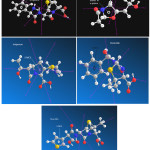 |
Figure 1: Ampicillin, Clavulanic acid, imipenem, Penicillin G and Ticarcillin structures |
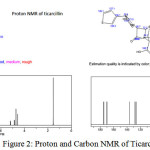 |
Figure 2: Proton and Carbon NMR of Ticarcillin
|
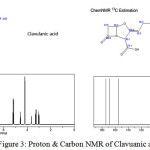 |
Figure 3: Proton and Carbon NMR of Clavuanic acid
|
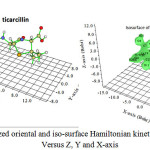 |
Figure 4: the optimized oriental and iso-surface Hamiltonian kinetic energy for Ticarcillin Versus Z, Y and X-axis
|
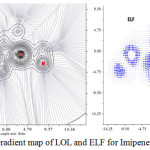 |
Figure 5: Gradient map of LOL and ELF for Imipenem in gas phase
|
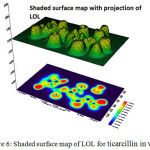 |
Figure 6: Shaded surface map of LOL for ticarcillin in water |
The fermi hole is a six-dimension function and as a result, it is difficult to be studied visually. Based those equations, Becke and Edgecombe noted that the Fermi hole is a spherical average of the spin which is in good agreement with our results in tables and Figs.
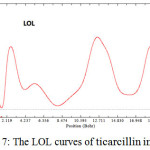 |
Figure 7: The LOL curves of ticarcillin in water |
According to the equations 16- 22 the largest electron localization is located on atoms which are bonded to nanotubes where the electron motion is more likely to be confined within that region. If electrons are completely localized in those atoms, they can be distinguished from the ones outside. As shown the large density is close to the bonded atoms. The regions with large electron localization need to have large magnitudes of Fermi-hole integration which would lead those atoms towards superparamagnetic.
Conclusion
Once a compound that fulfills all of these requirements has been identified, it will begin the process of drug development prior to clinical trials. Modern drug discovery involves the identification of screening hits, medicinal chemistry and optimization of those hits to increase some properties. One or more of these steps may involve computer-aided drug design. A fascinating result of the theoretical analysis of antibiotics- S-NICS methods were the stable model for drug delivery.
References
- Genc,Y.; Ozkanca, R.; Bekdemir, Y.; Ann Clin Microbiol Antimicrob 2008; 7, 7-17
CrossRef - Burkhart, CG. Open Dermatol, J, 2008, 2, 36-43
CrossRef - Owa, T.; Nagasu, T.; Exp Opin Ther Pat. 2000, 10, 1725-1740
CrossRef - Ogden, R. C.; Flexner, C. W. Protease inhibitors in AIDS therapy. New York, U.S.A: Marcel Dekker, 2001
- Nishimori, I.; Vullo,D.; Innocenti, A.; Scozzafava, A.; Mastrolorenz, A.; Supuran, C.T.; Bioorg Med Chem Lett., 2005, 15,3828-3833
CrossRef - Li, J. J. .; Anderson, D.; Burton, E.G.; Cogburn, J.N.; Collins, J.T.; Garland, D.J.; Gregory, S.A.; Huang, H.C.; Isakson, P.C.; Koboldt, C.M.; Logusch, E.W.; Norton, M.B.; Perkins, W.E.; Reinhard, E.J.; Seibert, K.; Veenhuizem, A.W.; Zang, Y.; Reitz, D.B.; J. Med. Chem, 1995, 38, 4570
CrossRef - Boyd, A.E. Diabetes, 1988, 37, 847–850.
CrossRef - Claudiu, T.S.; Angela, C.; Andrea, S. Med. Res. Rev, 2003, 23
- Braschi, I.; Blasioli, S.; Gigli, L.; Gessa, C.E.; Alberti, A.; Martucci. A.; J. Hazard. Mat. 2010, 178, 218
CrossRef - I. Braschi, G.; Gatti, G.; Paul, C.E.; Gessa, M.; Cossi, L.; Marchese. Langmuir 2010, 26 (12) 9524.
CrossRef - Boxall, A. B. A.; Fogg, L. A.; Blackwell, P. A.; Kay, P. ; Pemberton, E. J. and Croxford, A, Veterinary medicines in the environment, Reviews of Environmental Contamination and Toxicology, 2004 180, 1-91
CrossRef - Thiele-Bruhn, S. Journal of Plant Nutrition and Soil Science, 2003, 166, 2, 145–167
CrossRef - MacKay, A. A. ; Canterbury, B. Journal of Environmental Quality, 2005, 34, 6, 1964-1971
CrossRef - Lertpaitoonpan, W.; Ong, S.K.; Moorman,T.B.; Chemosphere, 2009, 76, 4, 558-564
CrossRef - Bollag, J.M.; Dec, J.; Huang, P.M.; Advances in Agronomy, 1997, 63, 237-266
CrossRef - Suflita, J.M.; Bollag, J.M.; Soil Science Society of America Journal, 1981, 45, 297–302
CrossRef - Johnson, K.K.; Green, D.L.. ; Rife, J.P. ; Limon, L, Ann.Pharmacother, 2005. 29: 290-301
CrossRef - Strom, B.L., Schinnar, R.; Apter, A.J.; Margolis, D.J.; Lautenbach, E.; N. Engl. J. Med., 2003. 349:1628-1635
CrossRef - Bryskier, A.; Antimicrobial agents: antibacterials and antifungals. Washington D.C:ASM Press; 2005.
CrossRef - Anurag Srivastava, Srashti Jain, Nagawat,A.K.; Quantum Matter, 2013, 469-473
- Ilyin, A. M. Quantum Matter 2013, 205-208
- P. S. Yadav, D. K. Pandey, S. Agrawal, and B. K. Agrawal,Quantum Matter , 2014, 39-46
- Boxall, ABA .; Johnson, P.; Smith, EJ.; Sinclair, CJ.; Stutt, E.; Levy, LS.; J, Agric.; Food Chem 2006, 54:2288–2297
CrossRef - Chen-Wei Jiang, Xiang Zhou, Rui-Hua Xie, and Fu-Li Li,Quantum Matter , 2013, 353-363
- J.-Y. Guo, C.-X. Xu, F.-Y. Sheng, Z.-L. Jin, Z.-L. Shi, J. Dai, and Z.-H. Li,Quantum Matter 2013, 181-186
- Tolls J: Environ Sci Tech 2001, 35:3397–3406
CrossRef - Kan, C. A.; Petz, M.;. J. Agric. Food Chem. 2000, 48: 6397-6403
CrossRef - Thomas Görnitz, Rev. Theor. Sci. 2014, 2, 289-300
CrossRef - Franco, D. A., J. Webb and C. E. Taylor. Journal of Food Protein 1990, 53:178–185.
CrossRef - Micheal Arockiaraj,Rev. Theor. Sci. 2014, 2, 261-273
CrossRef - Giguere, S., J. F. Presscott, J. D. Baggot, R. D., Walker and. P. M. Dowling. Antimicrobial therapy in veterinary medicine. 4th edition Blackwell Publishing Ltd, Oxford, UK. 2006
- Sutiak, V., I. Sutiakova, M. Korenek, P. Krokavec, M.Kozak, J. Saly, and J. Neuschl. Hygiena Alimentorum. 2000, XXI: 113–115.
- Kozarova, I., D. Mate, R. Cabadaj and K. Hussein ,Hygiena Alimentorum. XXIII. 2002
- Strbske Pleso. High Tatras. SR, 5–7: 65–67. Booth, N. H.. Vet. Toxicology. 1973, 15:100.
- Kozarova, I., D. Mate, K. Hussein, K., Raschmanova, S.Marcincak, and P. Jevinova,. Acta Veterinaria. 2004, 54, 5-6, 427-435.
- Monajjemi, M.; Aghaie, H.; Naderi, F. Biochemistry (Moscow) 2007, 72, 6, 652-657 Times Cited: 18.
- Monajjemi, M.; Heshmat, M.; Aghaei, H.; et al. Bulletin of the Chemical Society of Ethiopia ,2007, 21 , 1
CrossRef - Paolo Di Sia,Rev. Theor. Sci. 2014, 2, 146-180
CrossRef - Kennedy, D.G.; Cannavan, A.; McCracken, R.J.; Journal of Chromatography A ,2000, 882,37–52
CrossRef - Göbel, A.; McArdell, C. S.; Suter, M. J.-F.; Giger, W. Anal. Chem. 2004, 76(16), 4756-4764
CrossRef - Zeinulla Zh.; Zhanabaev .;Tatyana Yu.; Grevtseva,Rev. Theor. Sci. 2014,2, 211-259
- Burcu Tüzün .; csakir Erkoç,Quantum Matter 2012,1, 136-148
CrossRef - Monajjemi, M.; Rajaeian, E.; Mollaamin, F.; et al. Physics and Chemistry of Liquids,2008, 46 , 3 ,299-306
CrossRef - Ditchfield, R. J. Chem. Phys, 1972, 56: 5688–5692
CrossRef - Katsuhiko Higuchi .; Masahiko Higuchi, Quantum Matter, 2015, 4, 56-62
CrossRef - Mollaamin, F.; Monajjemi, M.; Journal of Computational and Theoretical Nanoscience 2012, 9 , 4 , 597-601
CrossRef - Clissold, SP.; Todd, PA.; Campoli-Richards, DM.; Drugs, 1978, 33 (3), 183–241
CrossRef
- Vardakas, KZ.; Tansarli, GS.; Rafailidis, PI.; Falagas, ME. The Journal of antimicrobial chemotherapy 2012, 67 (12): 2793–803
CrossRef
- Lee, V.S.; Khaleghian, M.; B. Honarparvar, B.; F. Mollaamin, F. J. Phys.Chem C. 2010, 114, 15315
- Monajjemi, M. Struct Chem. 2012, 23,551–580
CrossRef - Monajjemi, M.; Boggs, J.E. J. Phys. Chem. A, 2013, 117, 1670 −1684
CrossRef - Monajjemi, M.; Khaleghian, M, Journal of Cluster Science. 2011, 22 (4), 673-692
CrossRef - Mollaamin, F.; Varmaghani, Z.; Physics and Chemistry of Liquids. 2011, 49 318
CrossRef - Razavian, M.H.; Mollaamin,F.; Naderi,F.; Honarparvar,B.; Russian Journal of Physical Chemistry A , 2008 , 82 (13), 2277-2285
- Faham, R.; Mollaamin, F. Fullerenes, Nanotubes, and Carbon Nanostructures, 2012 20, 163–169
CrossRef - Monajjemi, M. Chemical Physics. 2013, 425, 29-45
CrossRef - Ketabi, S.; Amiri, A. Russian Journal of Physical Chemistry, 2006, 80 (1), S55-S62
- Monajjemi, M.; Wayne Jr, Robert. Boggs, J.E. Chemical Physics. 2014, 433, 1-11
- Honarparvar, B.; Nasseri, S. M. .; Khaleghian M. Journal of Structural Chemistry. 2009, 50, 1, 67-77
CrossRef - Monajjemi, M. Falahati, M.; Mollaamin, F.; Ionics, 2013, 19, 155–164
CrossRef - Monajjemi, M.; Mollaamin, F. Journal of Cluster Science, 2012, 23(2), 259-272
CrossRef - Tahan, A.; Monajjemi, M. Acta Biotheor, 2011, 59, 291–312
CrossRef - Lee, V.S.; Nimmanpipug, P.; Mollaamin, F.; Kungwan, N.; Thanasanvorakun, S..; Russian Journal of Physical Chemistry A, 2009, 83, 13, 2288–2296
- Mollaamin, F.; Monajjemi, M. Physics and Chemistry of Liquids .2012, 50, 5, 2012, 596–604
- Monajjemi, M.; Khosravi, M.; Honarparvar, B.; Mollaamin, F.; International Journal of Quantum Chemistry, 2011, 111, 2771–2777
CrossRef - Mahdavian, L.; Monajjemi, M.; Mangkorntong, N. Fullerenes, Nanotubes and Carbon Nanostructures, 2009, 17 (5), 484-495
CrossRef - Afsharnezhad, S, Jaafari, M.R..; Mirdamadi, S..; Mollaamin, F..; Monajemi, H. Chemistry .2008, 17 (1), 55-69
- Monajjemi, M. Theor Chem Acc, 2015, 134:77 DOI 10.1007/s00214-015-1668-9
CrossRef - Monajjemi, M. Journal of Molecular Modeling , 2014, 20, 2507
CrossRef - Monajjemi, M.; Khaleghian, M.; Mollaamin, F. Molecular Simulation. 2010, 36, 11, 865–
- Monajjemi, M. Biophysical Chemistry. 2015 207,114 –127
CrossRef - Sarasia, E.M.; Afsharnezhad, S.; Honarparvar, B.; Mollaamin, F.; Physics and Chemistry of Liquids. 2011, 49 (5), 561-571
CrossRef - Jalilian,H.; Monajjemi, M. Japanese Journal of Applied Physics. 2015, 54, 8, 08510
- Mahdavian, L.; Monajjemi, M. Microelectronics Journal. 2010, 41(2-3), 142-149
CrossRef - Monajjemi, M.; Baie, M.T.; Mollaamin, F. Russian Chemical Bulletin.2010, 59, 5, 886-889
CrossRef - Darouie, M.; Afshar, S.; Zare, K.. journal of Experimental Nanoscience.2013, 8, 4, 451-461
- Amiri, A.; Zare, K.; Ketabi, S. Physics and Chemistry of Liquids. 2006, 44, 4, 449-456.
CrossRef - Zonouzi, R.;Khajeh, K.; Ghaemi, N. Journal of Microbiology and Biotechnology. 2013, 23, 1 ,7-14
CrossRef - Mehrzad, J., Monajjemi, M., Hashemi, M , Biochemistry (Moscow).2014 , 79 (1), 31-36
CrossRef - Majid Monajjemi *, Samira Bagheri, Matin S. Moosavi, Nahid Moradiyeh, Mina Zakeri, Naime Attarikhasraghi, Nastaran Saghayimarouf, Ghorban Niyatzadeh, Marzie Shekarkhand, Mohammad S. Khalilimofrad, Hashem Ahmadin and Maryam Ahadi, Molecules 2015, 20, 21636–21657; doi:10.3390/molecules201219769
CrossRef - Majid Monajjemi and Nayyer T. Mohammadian J. Comput. Theor. Nanosci. 2015 12, 4895-4914
CrossRef - U. Haeberlen, In Advances in Magnetic Resonance, Suppl. 1 Academic Press, New York
- I. Bertini, C. Luchinat, and S.Aime, Coordin.Chem. Rev. 1996. 150, 29,
CrossRef - F.A.L. Anet and D.J O’Leary. The shielding tensor. Part II: Concepts Magn. Reson. 1992. 4, 35.
CrossRef - J. Herzfeld, A. E. Berger, J. Chem. Phys.1980, 73(45), 6021
CrossRef - U. Haeberlen, In Advances in Magnetic Resonance, Suppl. 1 Academic Press, New York (1976), M. Mehring.M, Principles of High Resolution NMR in Solids, 2nd.ed, Springer Verlag, Berlin, H. W. Spiess, In NMR Basic Principles and Progress; P. Diehl, E. Fluck, R. Kosfeld, Eds.; Springer Verlag, Berlin, 1978,. 15.
- D. P, Raleigh, F. Creuzet, S. K Das Gupta, M. H Levitt, and R. G Griffin. J. Am. Chem. Soc. 1982 , 111, 4502
- Lu T, Chen F , Acta Chim. Sinica, 2011, 69, 2393-2406
- Lu T, Chen F , J. Mol. Graph. Model , 2012, (38): 314-323
- Lu T, Chen F , Multiwfn: A Multifunctional Wavefunction Analyzer, J. Comp. Chem. , 2012 (33) 580-592
CrossRef - R.F.W. Bader, atoms in Molecule: A quantum Theory (Oxford Univ. press, Oxford, 1990
- Becke and Edgecombe J. Chem. Phys., 92, 5397
- Savin et al Angew. Chem. Int. Ed.Engl., 31, 187,
- Tsirelson and Stash, Chem. Phys. Lett., 351, 142
- Schmider and Becke, J. Mol. Struct. THEOCHEM , 527, 51
CrossRef

This work is licensed under a Creative Commons Attribution 4.0 International License.









